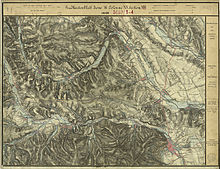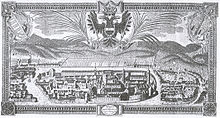Kőszeg
| Kőszeg | ||||
|
||||
| Basic data | ||||
|---|---|---|---|---|
| State : | Hungary | |||
| Region : | Western Transdanubia | |||
| County : | Vas | |||
| Small area until December 31, 2012 : | Kőszeg | |||
| District since 1.1.2013 : | Kőszeg | |||
| Coordinates : | 47 ° 23 ' N , 16 ° 33' E | |||
| Height : | 284 m | |||
| Area : | 54.65 km² | |||
| Residents : | 12,077 (Jan. 1, 2011) | |||
| Population density : | 221 inhabitants per km² | |||
| Telephone code : | (+36) 94 | |||
| Postal code : | 9730 | |||
| KSH kódja: | 16832 | |||
| Structure and administration (as of 2019) | ||||
| Community type : | city | |||
| Mayor : | Béla Básthy (Fidesz-KDNP) | |||
| Postal address : | Jurisics tér 8 9730 Kőszeg |
|||
| Website : | ||||
| (Source: A Magyar Köztársaság helységnévkönyve 2011. január 1st at Központi statisztikai hivatal ) | ||||
Kőszeg [ ˈkøːsɛɡ ] (German Güns , Croatian Kiseg ) is a city in Hungary . It is located in the west of Vas County (German: Eisenburg ), two kilometers from the Austrian border, on the right bank of the Güns stream ( Gyöngyös in Hungarian ) and at the foot of the Günser Mountains, the eastern foothills of the Alps. Kőszeg is the capital of the district of the same name .
history

The emergence of the only royal free town of the historical castle district Vas / Eisenburg goes back to the third quarter of the 13th century. It owes its foundation to the family branch Volfer (also called Wolfger) from the von Héder family , who settled in Hungary in 1157. Before 1274, the central court of the Kőszegi family ( Lords of Güns , also called Güssing Counts), who had left the family, was transferred to Kőszeg / Güns by Heinrich II. Von Heder and his son Ivan (also: Johann I. von Heder). For decades the city was the seat of these Güssing counts. It was not until 1327 that Karl von Anjou finally broke the power of the Güssing in West Pannonia and one year later (1328) elevated the city to the rank of a royal free city. During the rule of the Anjou (1347-1381) the city limits were also fortified. In 1392 the king's city became manorial when the palatine Nikolaus Garai repaid a pledge of the Ellerbach von Monyorókerék family that had been paid to King Sigismund of Luxembourg . The Garai era ended in 1441.
In the third wave of the great Turkish wars of the 16th century, Güns became the most important scene of the Ottoman campaign of 1532 towards Austria. Between August 5 and 30, 19 violent assault attacks were carried out against the city by Grand Vizier Ibrahim ( siege of Kőszeg ). Under the leadership of the town and castle commander Baron Nikola Jurišić (Hungarian: Miklós Jurisics ), the small castle garrison managed to repel an Ottoman army of 80,000 men.
After the last unsuccessful onslaught of the Turks, the Turkish army command was forced to give up the siege by a revolt of the Janissaries . According to tradition, the last contingent of withdrawing Turkish troops is said to have left the city limits at 11 a.m. To commemorate this historic act, the church bells in Güns have been ringing at 11 a.m. since 1777.
After the Turkish Wars, the castle and dominion of Güns came into the possession of the Esterházy family in 1695 , with whom they remained until 1931. The strategic importance of the city was lost after the Rákóczi freedom struggle of 1703–1711. In addition to Szombathely , Güns was the most important fortress for the military leadership of the Kuruzen from 1705–1708 in the liberation and preservation of the Hungarian territories west of the Raab . The royal free city experienced the longest peaceful epoch in its history in the 18th century. For the first time in the city's history, attempts were made to compensate for the population losses in 1712 by recruiting colonists and by founding Schwabendorf ( Kőszegfalva ).
The baroque Trinity column with statues of saints on the octagonal pedestal on the historic market square commemorates the plague of 1712.
Güns lost the leading role in the Eisenburg Castle District as early as the first half of the 19th century. The production crisis in the guild system during the Hungarian pre-March period (the age of reform at the beginning of the 19th century) was only able to survive a few handicraft businesses. The establishment of joint-stock companies, associations and the first financial institute in the county testify to the early bourgeois urban development. In addition to the typical society of small businesses and retailers, Güns developed into a city of schools, sanatoriums and garrisons during this period. The particularly beautiful and valuable natural and building stock remained unaffected by the developments and consequences of the capital employed. Usually only the gate bastions at the fortifications were damaged. The urban structure remained unchanged. In 1978 Güns was awarded the Hild Prize, a Hungarian architecture prize, for the preservation of the architectural heritage .
Today Güns is one of the most beautiful cities in Hungary (also called “Hungary's jewel box”) and a vacation spot.
population
The 2011 census showed 11,666 inhabitants, of whom 10,693 declared themselves to be ethnic Hungarians (92%), 609 as Hungarian-Germans (5.2%) and 263 as Croatians (2.2%). The proportions of religions in 2011 were as follows: 50% Roman Catholic, 2.2% Lutheran, 7.1% Calvinist, 0.6% atheist , 39% without an answer, 1.7% others. Unemployment was in 2011: 3.9%.
Population development
| year | number | Remarks |
|---|---|---|
| 1833 | 5,373 | "Mostly Germans with few Hungarians" |
| 1857 | 7,317 | 6,436 German speakers (88%), 881 Hungarians (12%) |
| 1880 | 7,301 | 5,290 German speakers (72.5%), 1,458 Hungarians (20%), 191 Croatians (2.6%) |
| 1910 | 8,423 | 3,066 German speakers (36.4%) |
| 1920 | 8,492 | 3,314 German speakers (39%) |
| 1941 | 10,320 | 1555 German speakers (15.1%) |
| 2011 | 11,166 | 10,693 Hungarians (92%), 609 Hungarian Germans (5.2%), 263 Croatians (2.2%) |
Worth seeing
- Jurisics Castle with Castle Museum , reopening after renovation and restoration in summer 2012
- Main square, pedestrian zone since 2006
- Inner city with medieval buildings, within the moat ( Várkör , actually "Burgring") largely restored
- Herz-Jesu-Kirche (neo-Gothic), parish church (construction period: 1892–1894); Architect Ludwig Schöne ( Vienna )
- Kőszeg synagogue , abandoned to ruin since 1944
- Steirerhäuser in the Günser Mountains (since 1750)
- Pharmacy Museum Apotheke zum Goldenen Einhorn at Jurisics Platz 11. Founded: 1777.
- Günser Mountains (Kőszegi hegység)
- Geschrittenstein (Írott-kő) is at 884 m the highest point in Burgenland and western Hungary .
- Siebenbründel (Hétforrás) , popular hiking destination from Kőszeg and also from Rattersdorf.
- Watchtower (Óház) (609 m), the first Güns castle was built here in the 13th century.
- Günser giant plane ( Kőszegi Óriásplatán ) , about 350 years old, 28 m high with a circumference of 9 m.
traffic
Köszeg / Güns is located 18 km northwest of Szombathely . The county capital can be reached via the national road 87 and with the GySEV via a single-track, non-electrified railway line since August 1, 1883. From November 5, 1908, Güns was the terminus of the Burgenland Railway .
A cross-border extension in the direction of Oberpullendorf , Deutschkreutz and Sopron was proposed by the Burgenland. A road border crossing leads to the Austrian Kirchschlager Straße (B 55) or indirectly the Günser Straße (B 61) to Rattersdorf ( Rőtfalva ) or Lockenhaus .
On the Austrian side, the S 31 Burgenland expressway continues with the planned M87 expressway via Kőszeg / Güns to Szombathely . After 2014, the Günser expressway with the 4-lane expansion is planned.
Sports
In Güns there is the Síugrás ski jumps, a training center for Nordic skiing consisting of several jumps.
Twin cities
Kőszeg / Güns is a member of the international association Douzelage . Other city partnerships connect the city with, among other things
-
 Offenbach am Main
Offenbach am Main
-
 Vaihingen an der Enz in Baden-Württemberg ,
Vaihingen an der Enz in Baden-Württemberg , -
 Mödling in Austria ,
Mödling in Austria , -
 Senj in Croatia ,
Senj in Croatia , -
 Nitrianske Hrnčiarovce , Okres Nitra , Slovakia .
Nitrianske Hrnčiarovce , Okres Nitra , Slovakia .
sons and daughters of the town

- Andreas Hadik von Futak (1711–1790), Austrian imperial count and field marshal
- Samuel von Giffing (also Giefing ) (1758–1813), Imperial and Royal Major General, killed in the Battle of Leipzig, commander of the "Brigade Giffing"
- Philipp Schey von Koromla (1798–1881), wholesaler and philanthropist, founder of the synagogue
- Friedrich Schey von Koromla (1815–1881), Austrian banker and patron
- Louise Weinlich-Tipka (1829–1907), singer
- Marie Herzfeld (1855–1940), writer, literary critic and translator
- Sándor Kárpáti (1872–1939), composer
- Nikolaus Graf von Üxküll-Gyllenband (1877–1944), businessman, colonel zV and resistance fighter of July 20, 1944
- Gyula Lóránt (1923–1981), football player and coach
- József Fabcsics , translator
- Attila Horváth (* 1967), discus thrower, bronze medalist at the 1991 World Athletics Championships
Other personalities associated with the city
- Herren von Güns , family of the town's founders, also called Güssinger
- Géza Ottlik , Hungarian writer, attended the military secondary school in Kőszeg and wrote the novel Iskola a határon ("School on the border")
- Ágota Kristóf , Hungarian-Swiss writer, spent several years of her childhood in Güns, processed in the novel Das große Heft
literature
- Elisabeth Gmoser: History of the rule of Güns as an imperial chamber property under Austrian administration (1491–1647). Office of the Burgenland Provincial Government, Eisenstadt 2002. ISBN 3901517375
Web links
- Official website of the city of Kőszeg (HU, EN, DE, FR, IT)
- Kőszeg , in: A Pallas nagy lexikona (Hungarian)
Footnotes
- ↑ Önkormányzat 2019 - Tízezernél több lakosú települések polgármesterei - Vas megye - Eredmény. Webrádió, October 14, 2019, accessed November 5, 2019 (Hungarian).
- ↑ Historical population of Vas (Hungarian Central Statistical Office) (PDF; 1.9 MB)
- ^ JC von Thiele, The Kingdom of Hungary. A topographical-historical-statistical Kundgemolder, Volume 5 (Kaschau 1833), pp. 79–80.
- ^ Arnold Suppan, "Germans" in the Habsburg Empire. Language, Imperial Ideology, National Identity, and Assimilation, in: Charles W. Ingrao et al., The Germans and the East (West Lafayette 2008), p. 182.
- ^ Arnold Suppan, "Germans" in the Habsburg Empire. Language, Imperial Ideology, National Identity, and Assimilation, in: Charles W. Ingrao et al., The Germans and the East (West Lafayette 2008), p. 182.
- ^ Arnold Suppan, "Germans" in the Habsburg Empire. Language, Imperial Ideology, National Identity, and Assimilation, in: Charles W. Ingrao et al., The Germans and the East (West Lafayette 2008), p. 182.
- ↑ http://www.nepszamlalas2001.hu/hun/egyeb/nemet/data/telepules_d.html
- ↑ town twinning. From: offenbach.de, accessed on March 25, 2018.






